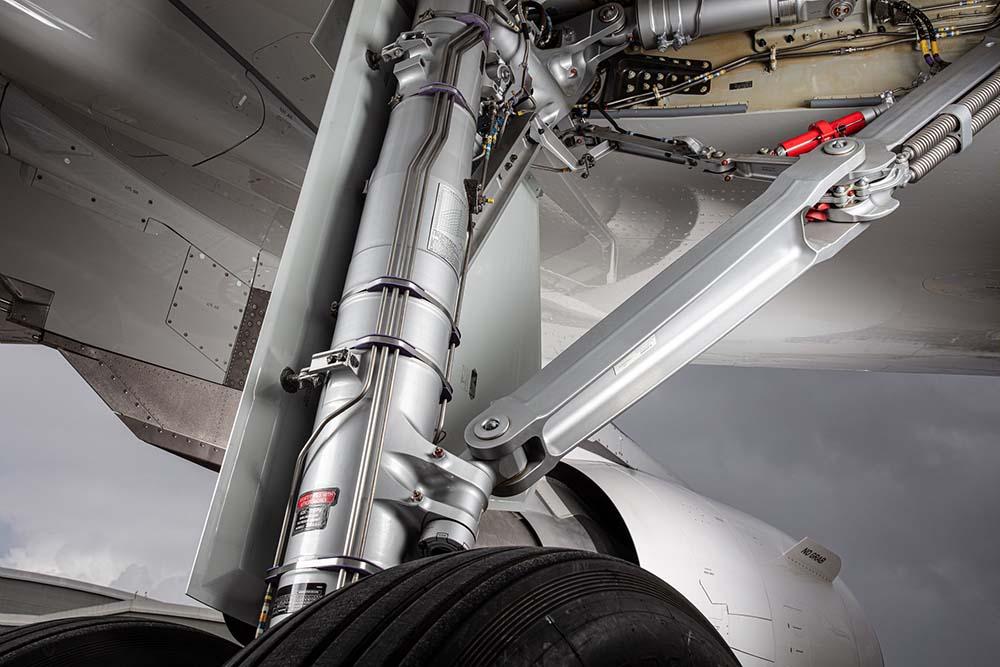
Continued surges in titanium prices will impact pricing in aircraft landing gear.
Aerospace material prices have recovered from their sharp surge at the beginning of the Ukraine War, but part prices are likely in the future to reflect general inflation in material and labor markets.
Reviewing more than a million data points on part prices in 55 ATA chapters collected by Inventory Locator Service (ILS), Chief Marketing Officer E.J. Schmidt says the general trend from 2021-22 “was zero to low single-digit percentage declines in most ATA chapters.” This trend was based on both new and used parts.
Schmidt notes several trends in the most frequently traded categories, including both rotables and non-rotables. For new air conditioning, pressurization, equipment and furnishing parts, there was flat pricing for airline aircraft year-over-year. Hydraulic power new part pricing was also flat from 2021-22. But for new airline door parts, prices registered low single-digit increases, as did prices for fuselage parts.
Used air conditioning and pressurization part prices posted low- to mid-single digit percent decreases for commercial aviation from 2021-22. Used pricing for indicating and recording system parts registered mid-single digit percentage decreases for airline aircraft. Used landing gear part prices declined by low to mid-single digit percentages. Used navigation part prices declined by high single digit percentages for airlines. New APU prices showed a low single digit percent decline.
The story was similar for engine parts. New general engine parts showed modest single digit percent declines from 2021-22. New power plant part prices declined by mid-single digit percentages, as did prices for new engine fuel control parts. Used general engine parts declined by modest single digit percentages, as did new parts for engine exhaust systems for commercial aircraft.
Thus, even with general inflation increasing, a still-depressed airline market helped keep part pricing low. This occurred as material prices surged temporarily after the Ukraine War began.
For example, titanium is important to production of engines, landing gear and airframes. Spot titanium prices surged 160% briefly in May 2022, but are now down to only 21% above pre-war levels. However, the consultancy Trading Economics predicts titanium prices will rise by about a quarter in the next two years.
Nickel is used in engines and avionics systems. Spot nickel prices more than doubled in March 2022, but are now down to 28% above pre-war levels. Trading Economics predicts about another quarter rise in nickel prices by the end of 2024.
Even with wider use of composites on the newest aircraft, aluminum remains critical to structural aircraft parts. Spot aluminum prices were up nearly 50% as the Ukraine War began, but have dropped 13% below pre-war levels. Trading Economics foresees a further decline in the next two years.
And then there are those pesky semiconductor chips, which are crucial to aircraft electronic parts but which have been in short supply recently. Chip manufacturers boosted prices by huge margins from 2021-22, since Ukraine had previously supplied half the neon used in making chips. However, the outlook for 2023 increases appears more moderate. The world's largest contract maker of semiconductors, Taiwan Semiconductor Manufacturing Company, plans to hike its prices only 6% from 2022-23.
Aerospace OEMs usually buy materials at contract prices rather than spot prices, but sustained movements in spot prices alter contract prices as well. Except for aluminum, prices for major aerospace materials look headed upward.
Considering these trends, the prospects are for aerospace material costs to increase, but not too drastically. Labor is moving at a similar pace. The U.S. private employment cost index, which includes wages and benefits, has recently been rising at about 5% annually. In Europe, wage growth has been slower, at about 3% annually. Trading Economics expects a 2.3% increase in 2023 and 2.1% in 2024.
Unless part manufacturers and traders are squeezed further, or slackening demand or plentiful use parts depress prices, expect significant—but not dramatic—price increases to lie ahead.





